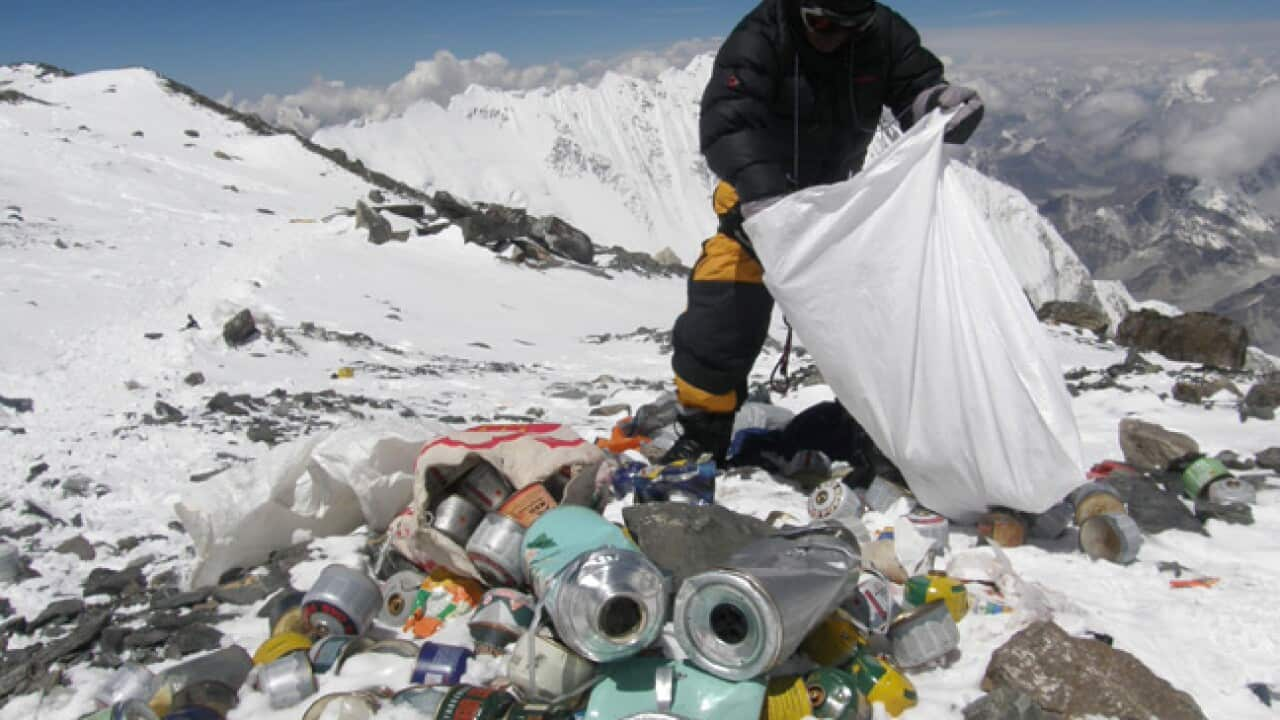Would you climb 8,848 meters to pick up other people's waste, discarded climbing gear and even the occasional dead body? This is what the Eco Everest Expedition sets out to do every year.
Professional mountain climbers like the Everest base camp about as much as hermits enjoy Oktoberfest. There are hundreds of tents at 5,600 meters altitude -- it's noisy and full of people.
Garbage is a hot topic here, at the base the world's highest mountain. Paul Thelen has been here twice, and knows the situation. “You're surrounded by filth,” he says over the phone, without the faintest trace of irritation or repugnance in his voice. Then again, as an active 68-year-old, Thelen has seen a lot in life.
He and a friend, Eberhard Schaaf, a mountain climber like himself, have come to Nepal to clean up garbage. The men are part of the annual Eco Everest Expedition (EEE) that has been clearing trash from the camp and the path to the top of the mountain since 2008. So far, these expeditions have collected over 13 tons of garbage, including several hundred kilos of excrement and a few corpses.
Thelen and Schaaf are the first Germans to take part in the expedition, which this year is made up of 16 climbers from seven countries. They will be on site until the end of May. And they want to get to the top – all 8,848 meters of it.
It's a dangerous endeavor. The Germans say they have two goals: to climb up and then to come back down. Both goals are difficult in themselves, but luckily one of their sponsors is Doppelherz, a manufacturer of energy tonics for seniors.
OLD TENTS, SCRAPS OF FABRIC AND A FEW CORPSES
Thelen, a management consultant from the German spa town of Aachen, says he has been dreaming about mountains since he read books about the Everest as a teenager. He's only been climbing very high mountains for a few years, though. Before that, he mostly stuck to marathons. With Eberhard Schaaf, a sports physician who is also from Aachen, he's climbed the Kilimanjaro (5,893 meters), Mount McKinley (6,194 meters), and in 2009 he made it up to the top of Argentina's Aconcagua (6,962 meters).
Thelen calls them their “practice mountains.” For Everest, he and Schaat trained intensively for a year, rope climbing at an ice rink, choosing stairs over elevators, generally toughening up. Not to be underestimated was the mental preparation, which can be half the battle, Thelen adds.
The expedition, as is the norm on Everest, is going to set up four camps that expedition members will climb up to several times to get used to the altitude and learn the way. Both they and Sherpas carry food and equipment up to the third camp at 7,200 meters, then climb down with empty backpacks.
They also carry sturdy nylon sacks that can be filled with 10 to 12 kilos of garbage including old tents, tent poles, fabric scraps, which are all frozen solid. All this equipment has been left by hundreds of climbers.
Most of the garbage has been there since the 1990s, when the boom in tourist expeditions began. And as global warming is also making the famous – and dangerous – Khumbu Glacier melt, even more detritus is appearing. The EEE has even found tin cans dating from 1962.
Everest has been climbed over 5,000 times, 80% of which since 2000. The mountain, which in Tibetan is known as the Mother of the Universe, has been dubbed the “highest garbage dump in the world.” Thelen says, however, that the situation is improving. A lot of trash has been removed, and new expeditions are more environmentally savvy.
It goes without saying that Thelen and Schaaf leave nothing behind, and use renewable energy and a heavy parabolic cooker instead of the lighter kerosene burner.
Taking your garbage down with you can mean life or death
Thelen understands why climbers leave so much refuse. “On Everest, after a certain altitude you devote your strength to climbing or coming down safely. You are totally preoccupied with that, nothing else.” Empty oxygen bottles are heavy, tents are often totaled by storms or snow, and climbers often just don't have the strength to schlep them along.
The “death zone,” where climbers lose strength even if they are not exerting themselves, begins at 7,000 meters. Here, dawdling brings certain death. It is not uncommon for climbers to die of exhaustion – in 2006 alone, 11 climbers died. And most are left where they died.
A major problem is human waste. At the base camp there are toilet tents, and the toilets are regularly emptied. At higher altitudes “clean mountain cans” (CMC) are used. CMC's have bags inside them that are emptied every two or three days. If the “death zone” has any positives, it's that at that height human digestion slows down to virtual standstill so the members of the expedition don't have to go that high to pick up waste.
This expedition is probably not going to be taking any corpses down the mountain, although past expeditions have. Until a few years ago, there were cadavers along the route and climbers had to pass them on the way down, in extremely dangerous and difficult circumstances, particularly through the Khumbu Icefall where narrow ladders are used.
Thelen says he doesn't feel fear – just respect. Here, people are just “fly droppings” he says: he would never speak of “conquering” a mountain. Without passion and absolute belief in its success, you might as well not bother, he says. Until 2007 only every fifth attempt to reach the top was successful: the number has gone up since. By the end of 2010, 3,100 people had made it to the top. Thelen and Schaat hope to be among the climbers adding to that number.

Share

